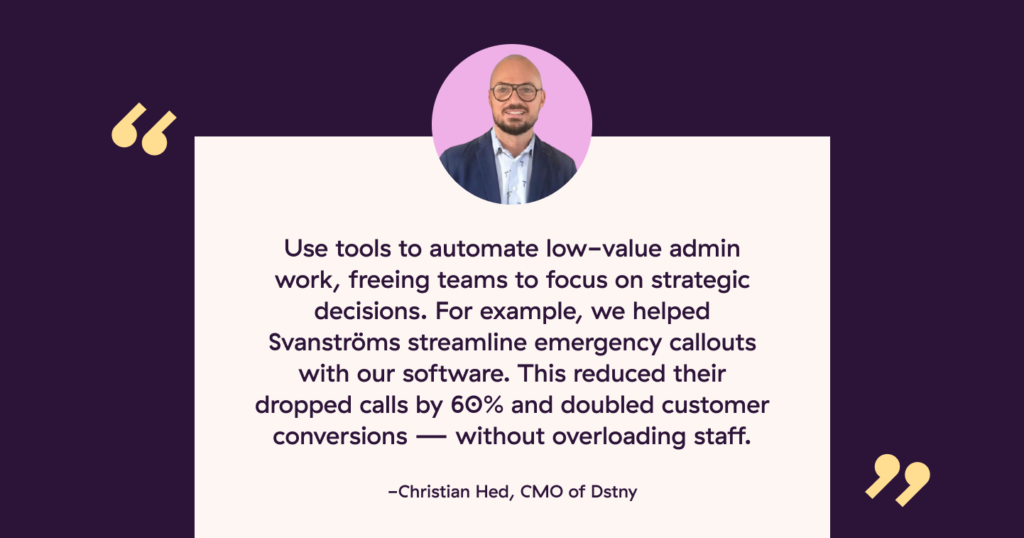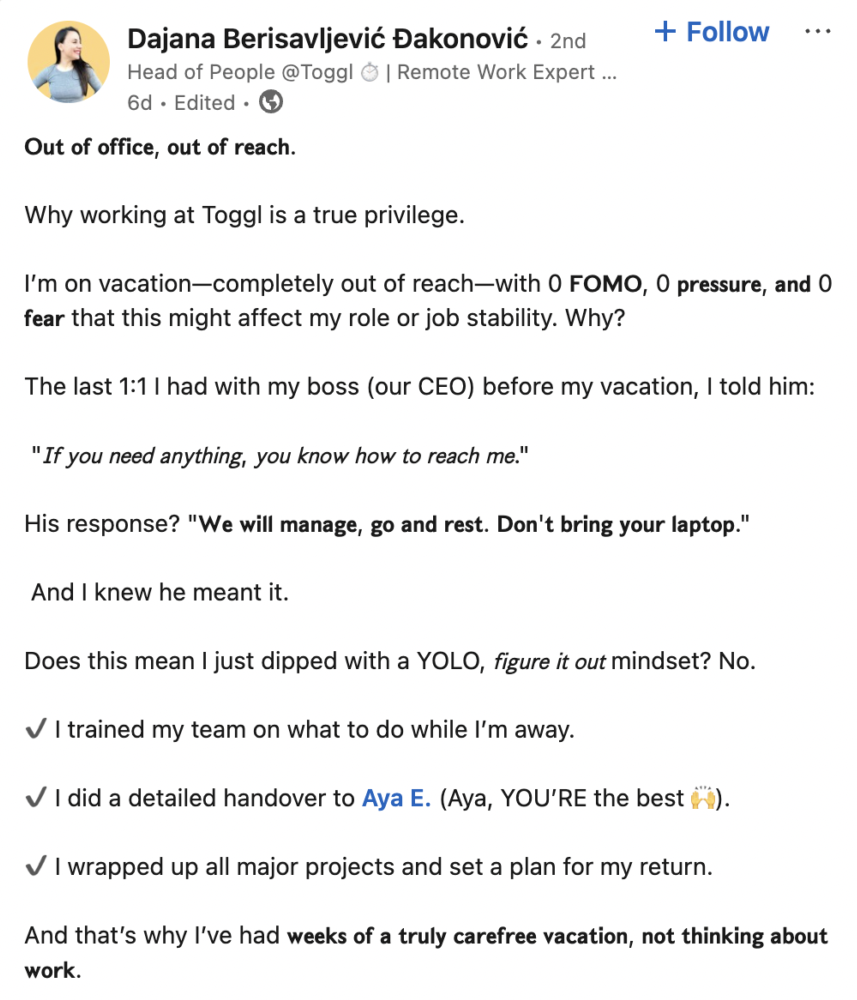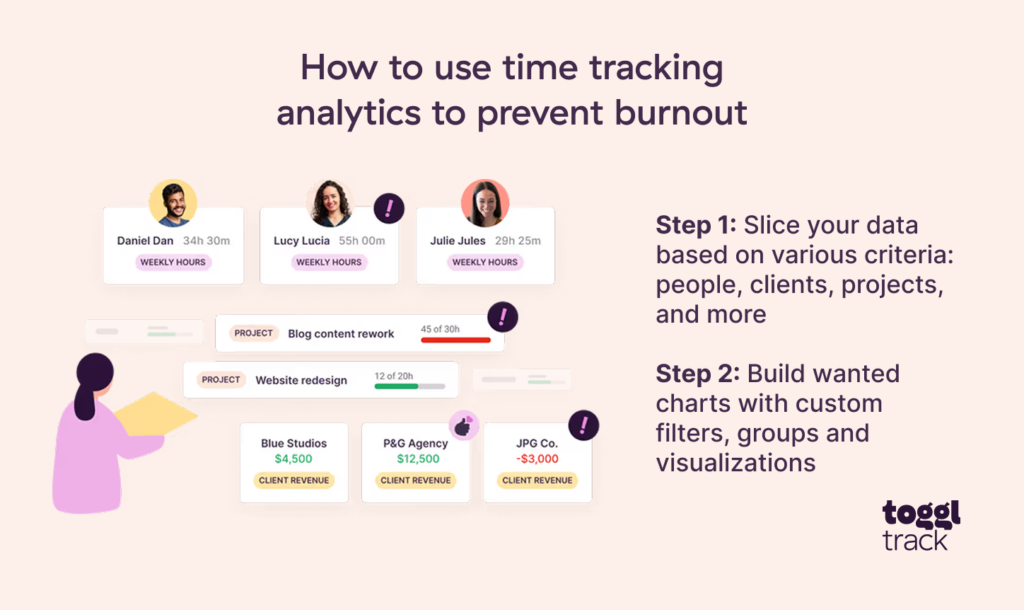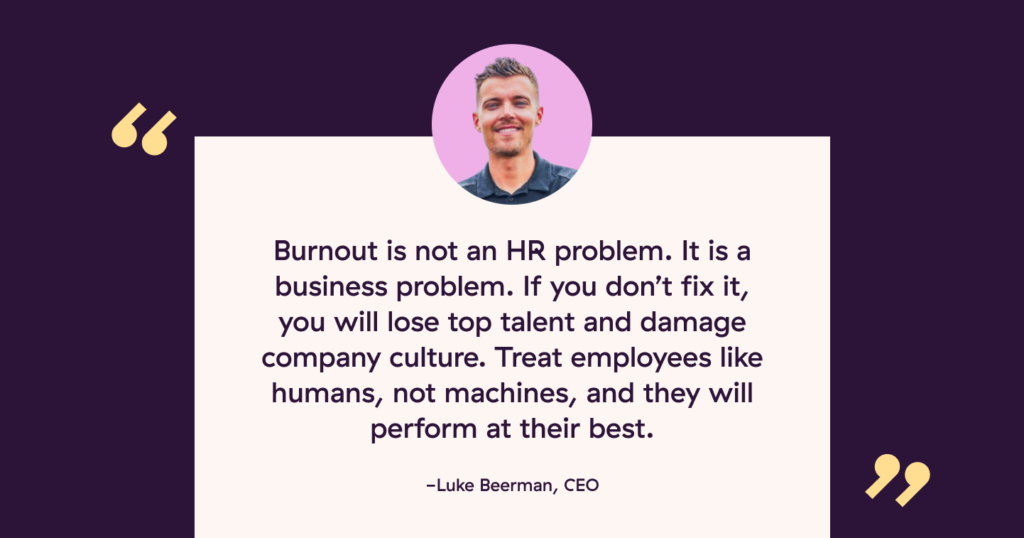A job isn’t just technical or physical effort; it’s also emotional labor…and many workers feel worn out.
Half of global workers (roughly 1.8 billion people) struggle with burnout. Women, members of the LGBTQ+ community, people with disabilities, and remote workers are even more likely to board the burnout express train repeatedly.
Feeling depleted after a long work marathon is normal, but continuously pushing yourself (or others) to perform at their limits is unsustainable. As a manager, you risk losing your best people, undermining team morale, and jeopardizing organizational success…while also boarding the same burnout express. 🚄
The good news? We’ve got plenty of tips and tricks to help you recognize, avoid, and overcome burnout in your organizations.
TL;DR — Key Takeaways
- Employee burnout manifests as reduced productivity, constant exhaustion, and emotional detachment from work. It can also include more severe physical symptoms, signaling overexertion.
- The scale of workplace burnout is growing every year as companies push for greater productivity, higher profitability, and faster results amid fast technology changes and financial uncertainty.
- Employee well-being often goes on the back burner, especially when businesses want to cut costs. But investments in your people pay manifold — in higher worker productivity, stronger talent retention, and better financial performance.
- To prevent employee burnout, managers need to be more intentional about managing workloads, assigning priorities, and monitoring performance. They can also work on modeling better lifestyle behaviors themselves.
- Pushing your people harder or resorting to workplace surveillance technologies is never the answer to higher people productivity. It’s another recipe for accelerating burnout and talent attrition.
- Responsible time-tracking tools like Toggl Track can diagnose the early signs of burnout, improve capacity management, and coach your people to build healthier productivity habits.
Detect the early signs of burnout
Use time data and analytics to better manage employee workload and capacity.
What does employee burnout look like?
Burnout is our bodies’ ‘shut-down’ reaction to unmanaged chronic workplace stress. It initially manifests as behavioral, psychological, and physiological cues:
- Decreased productivity due to mental fog, procrastination, and lack of motivation
- Growing self-doubt, personal insecurities, or hopelessness toward your job
- Increased irritability, cynicism, and emotional detachment from your work or distrust toward the employer
- Absenteeism and avoiding responsibilities, aka doing the bare minimum or quiet quitting
- Constant cognitive fatigue, lost concentration, and difficulties in rational decision-making
- Diminished self-worth and accomplishments when no work feels ‘good enough’
- Troubled sleeping, changed appetite, weight loss, and more frequent mild illnesses like colds
- Chronic fatigue, muscle tension, headaches, and other signs of deteriorating physical wellbeing
The first signs of job burnout are often subtle. “It’s tough to spot burnout because many people hide it, as they don’t want to seem unreliable or risk falling behind, especially in a hustle culture like the one in America,” says Anand Mehta, Executive Director of AMFM Healthcare.
Burnout can also be confused with regular workplace stress, which is often temporary and doesn’t result in overwhelming depletion. Because of this confusion, managers often fail to notice the early warning signs or write these off as character flaws like poor time management or a lack of work ethic.
Unlike workplace stress, which can temporarily boost performance, burnout paralyzes people’s ability to do better, no matter how hard they try. And this makes it dangerous to ignore.
How common is employee burnout?
Workplace burnout is pervasive.
At the start of 2025, over two-thirds (66%) of American employees and nine in ten (91%) Brits experienced high stress, emotional exhaustion, and severe lack of motivation.
Almost every role is affected — from healthcare workers recovering from the pandemic to deskless tech employees pressured to deliver faster, better work. Recent layoffs increased job insecurity and raised expectations for remaining employees. Meanwhile, remote workers struggle to disconnect and focus as employers adopt more invasive performance management software.
Combined with information overload, rapid technological change, skyrocketing living costs, poor management, and rising job demands — quite the melting pot — all these factors create fertile ground for burnout.
Sadly, burnout rates are growing at 15% year on year because companies expect employees to ‘work through their issues’ instead of changing their workplace cultures.
The most common causes of employee burnout
In 2019, the World Health Organization classified burnout as an “occupational phenomenon,” aka something induced by the nature of a person’s job, not their personal life circumstances.
“Burnout isn’t an employee issue; it’s a leadership failure. It doesn’t happen overnight, either. It’s a slow decline caused by overwork, lack of support, and unclear career growth,” says Luke Beerman, CEO of Freedom Fence FL.
Many workplaces suffer from systemic problems related to the work environment, management practices, and culture, increasing the risk of burnout.
Unsustainable workload
Occasional ‘busy’ periods are normal for every job, but your people can’t always be maxed out. No one can be on their A-game for eight hours, five (or more) days a week. The human brain simply isn’t designed for more than four hours of daily deep work.
Yet, there’s an alarming disconnect between managers’ and individual contributors’ perceptions of performance management. In terms of goal management, skill development, and capacity management, managers think they’re doing enough. Workers disagree.

Lack of progress visibility, poor team time management, and haphazard performance correction leave people with not enough time to handle unrealistic expectations. This accumulative pressure and overwork eventually lead to burned-out employees.
Toxic workplace practices
“We discourage sick days unless absolutely necessary”…..“Vacations longer than five consecutive work days won’t get approved”…..“We pit people against each other to determine top performers.” Sadly, all of these statements are still true and reflective of many companies’ cultures.
Three-quarters of US workers have faced a toxic workplace culture, with poor management as the main cause. Micromanagement, favoritism, unhealthy competition, harassment, bias, and disregard for employees’ mental or physical health all lead to burnout.
Sadly, people in customer and patient roles are at an even higher risk of emotional strain. If management pushes for a “the customer is always right” policy, your employees may be pressured to tolerate verbal abuse or physical violence. Ask anyone in an entry-level customer service job.
One in five workers experienced mental health problems at work, and 22% reported harassment in the last 12 months.
American Psychological Association
Lack of role clarity
In smaller companies, startups, and scale-ups, one person is often expected to ‘wear many hats.’ A Product Marketing manager can juggle their core tasks with occasional design, social media marketing, or sales chores. This strategy might work in the short term, but even high-performers can crumble under excessive workload and constant overwhelm over the longer term.
Confusion, urgency, and constant context-switching tax our brains, which weren’t designed to multitask. Only 2.7% of people can effectively do several things at once without losing performance. Yet, many workplaces ask their staff to juggle flaming torches while riding a unicycle (not literally, though).
The constant lack of control, changing priorities, and general confusion over expectations (especially when paired with low compensation) cause burnout.
Inadequate recognition or support
An alarming number of employees feel their efforts are taken for granted. Busy managers often fail to provide timely feedback, while more ambitious co-workers tend to take credit for team effort, which is highly demoralizing.
Only 1 in 3 workers recently received recognition for their good work. Worse, employees who don’t feel adequately recognized are twice as likely to quit in the next year.
Many managers think recognition equals a cash bonus. But what employees crave (and what works best) is “honest, authentic and individualized verbal recognition of their contributions,” according to Gallup.
It pays to invest in employee wellbeing
Content people are more engaged, productive, and creative. It’s a simple (but often overlooked) fact backed by research:
- Improving employee wellbeing in the UK can create extra economic value of £130-370 billion annually, or 6-17% of the country’s GDP. (McKinsey Health Institute)
- Companies with higher employee well-being financially outperform stock indexes like S&P 500, Russell 3000, and Nasdaq Composite. (Indeed)
- Employees at companies that prioritize their well-being are 71% less likely to report burnout and five times more likely to advocate for their company as an employer. (Gallup)
- 89% of employees will only consider companies that emphasize employee wellbeing when looking for their next role. (WellHub)
By making employee experience (EX) a higher-ranking priority, you can attract better talent and minimize the impacts of skills shortages. Plus, this strategy reduces employee attrition by ensuring greater job satisfaction and engagement.
Engaged people are less likely to show signs of absenteeism, resistance to change, or declining work quality. In fact, when employees are engaged, their productivity jumps by 21%, achieving business profitability leaps of 18%.
An investment in employee well-being comes with a direct financial return on investment and a host of non-tangible benefits like a stronger employer brand, greater capacity for innovation, and stronger leadership.
So, what’s the secret to preventing or eradicating workplace burnout?
Getting out of a burned-out state is much harder than preventing it. Workplace burnout recovery can take anywhere from three months to four years (in the most severe cases).
It’s worth remembering that burnout happens when work demands become too much, too often. So, the best thing you can do as a leader is to ‘turn down the heat’ through better communication, improved workplace incentives, and data-driven management decisions.
Dial down the urgency
“The expectation of constant availability results in burnout among employees. If employees can’t disconnect, burnout is bound to happen,” says Christian Hed, CMO of Dstny.
As the speed of business has accelerated, many companies have developed a culture of ‘fake urgency’ — unrealistic deadlines, fast email response times, clogged calendars, and overflowing to-do lists.
Most work tasks aren’t that urgent. They don’t require a ‘one-second response’ or an ‘immediate 10-person meeting.’ Companies like GitLab, Buffer, Automattic, and Toggl all succeed by relying on async communication.
Likewise, many ‘ultra urgent’ tasks can be automated instead of handled by humans — and that’s what Christian Hed advocates:
“Use tools to automate low-value admin work, freeing teams to focus on strategic decisions. For example, we helped Svanströms streamline emergency callouts with our software. This reduced their dropped calls by 60% and doubled customer conversions — without overloading staff.”

Don’t reward overwork
Many traditional workplace incentives, like bonuses or promotions, based solely on visible outputs, create a workaholic culture. The media doesn’t help, either. We’ve seen countless stories about top-class attorneys or smart doctors working ultra-long hours. But fewer about those leaving work at 4 pm to work on their veggie garden.
“The fix to burnout starts with stopping the reward system for overwork”, added Beerman. “Make PTO sacred so employees don’t feel guilty for taking breaks. Ditch the always-on mentality by setting real work-life boundaries.” These behaviors should start with managers because they can drain an entire team.
Do you personally have a good work-life balance? Or are you the one messaging your team at odd hours or on Sunday afternoons with random questions? Perhaps you should adjust your expectations and take greater care of your health, too.
Human Resources professionals can also provide support by creating and reinforcing systems to promote self-care without sacrificing organizational performance. These can include:
- Adopting results and accountability first (RAFT) policies, where employers recognize their people by output and impact rather than input like clocked hours
- Granting employees the autonomy to set their own schedule for roles that allows this
- Offering paid personal time off and encouraging people to use it without any guilt
- Enforcing a no-contact policy outside of working hours, protecting the right to disconnect
- Signposting various wellness programs to help people better cope with stress or mental health issues
Because when your people can disconnect (properly, without FOMO,) they return more productive and engaged than ever.

Use data to inform your strategy
Employee burnout comes from prolonged exposure to stressors. To prevent this condition from taking hold, learn when exposure reaches a tipping point — and work on preventing these build-ups.
“One of the most obvious symptoms of burnout is a change in the employee’s level of engagement, whether it be a decrease in enthusiasm over projects that were once loved, an increase in absenteeism, or even changes in personality, such as irritability or withdrawal,” says Lucas Botzen, HR Expert and CEO of Rivermate. Diagnosing and addressing these root causes is the key step to breaking up the burnout cycle, according to Botzen.
Managers often notice burnout symptoms first but aren’t always equipped to diagnose the cause. Productivity tools like Toggl Track can provide deeper insights. Our analytics dashboards can help identify when your people are focusing on the wrong priorities and risking project delays (or if they simply feel too overwhelmed due to insufficient capacities).

Time data also helps you understand what undermines productivity and drives exhaustion. Perhaps your engineers are stuck in too many meetings. Or your procurement team is held back by your legacy, slow ERP systems.
“We regularly review our people’s performance and adjust workflows to keep things manageable. These small but intentional changes have made a big difference in helping the team feel supported and valued,” agrees Mehta.
Aim to build a high-trust culture
All of the above efforts improve workers’ physiological safety, allowing them to raise issues in time without fear or judgment. “I really insist on open communication and regular one-on-one check-ins with managers as a means of catching the signs before they escalate,” says Botzen.
Candid and empathetic conversations with managers, especially for remote teams, are critical for building trust, a key pillar of employee retention. It’s also important to normalize discussions about not just ‘big wins,’ but also mishaps, personal struggles, and ways to overcome them.
Burnout is (usually) about the workplace, not the people
Burnout susceptibility isn’t about skills, work experience, or emotional resilience. Entry-level customer support agents, world-class neurosurgeons, recent accounting graduates, and even CEOs can experience burnout.
Usually, it’s due to poor leadership decisions, reinforced by the glorification of entrepreneurs (Elon-ahem-Musk), who “work 120-hour weeks and didn’t take more than a week off for 17 years.” Wow, doesn’t that sound fun?
Leaders’ personal disregard for employees’ well-being taints the entire company culture. People are asked to achieve unachievable targets for company growth, clock in excessive overtime, and work to the point of depletion.
Corporate work cultures have even been blamed for the death of some employees, such as in the heartbreaking story of one 26-year-old E&Y worker who died within four months of joining the consulting firm.
As managers, we can switch from blaming to helping employees better cope with stress.

This starts with intentionally allocating workloads and using tools to measure your team’s capacity and capability. Team restructuring to accommodate mounting work is another solution, along with business process optimization to eliminate redundancies. If you lack hands on deck, petition stakeholders for extra hiring budgets and push back on unrealistic expectations from higher-ups.
As an executive leader, it’s your job to listen to your people and act on their feedback. If productivity or profitability declines, it’s not always because your teams aren’t doing enough. Often, they may be stretched too thin and lack the resources to meet their targets.
Finally, cultural initiatives like training in new leadership styles, emotional intelligence workshops, and sustainable productivity goals can make a difference. Speaking of which…
Surveillance is definitely not the key to employee engagement
The flip side of burnout is low employee engagement and productivity — something that’s been bothering leaders a lot.
But instead of defining adequate productivity criteria for different roles, an alarming 75% of respondents to our Toggl Productivity Index survey believe they should have the right to track every employee’s activity to ensure they are delivering results.
The adoption of employee surveillance software is on the rise, with companies logging remote employees’ keystrokes, browser activity, and number of blinks per second via a webcam.
Chief Surveillance Officers, as we like to call them, often achieve the opposite of what they’re hoping for. Their people engage in ‘productivity theater’ — a flurry of meaningless output activity with little impact. They become less autonomous, demotivated, and eventually quit, leading to painful impacts on your business’s bottom line.
TLDR: Surveillance and micromanagement only aggravate employee burnout, but never fix it.
To increase your team’s productivity, you need to consider more strategic changes to your project management, workload allocation, and personal accountability. This starts with gaining better visibility into your workloads.
Toggl Track advocates for time data collection to support, not stifle, your people. Our automatic time tracker allows users to stay in control of all logged time data. We have a fierce anti-surveillance policy.

Instead, our mission is to give everyone visibility into how work happens, using actionable data for optimizing:
- Workload distribution and task allocation, based on capacity availability
- Project duration and profitability by eliminating time-wasting steps
- People’s time management habits and focus on doing deep work
Get your team back on track
Workplace burnout has an all-around negative impact on businesses: You lose efficiencies, revenue, and top talent. But it’s also really hard to spot, especially in larger teams, unless you can really zoom in on your people’s work habits.
Toggl Track transforms your team members’ time entries into multi-dimensional data for tracking project performance, forecasting delays, and identifying unsustainable workloads. Optimize your people’s productivity and well-being by helping them build better time management habits designed for a healthy work-life balance and consistently high personal impacts.
Try out Toggl Track analytics features for free!
Elena is a senior content strategist and writer specializing in technology, finance, and people management. With over a decade of experience, she has helped shape the narratives of industry leaders like Xendit, UXCam, and Intellias. Her bylines appear in Tech.Co, The Next Web, and The Huffington Post, while her ghostwritten thought leadership pieces have been featured in Forbes, Smashing Magazine, and VentureBeat. As the lead writer behind HLB Global’s Annual Business Leader Survey, she translates complex data and economic trends into actionable insights for executives in 150+ countries. Armed with a Master’s in Political Science, Elena blends analytical depth with sharp storytelling to create content that matters.


